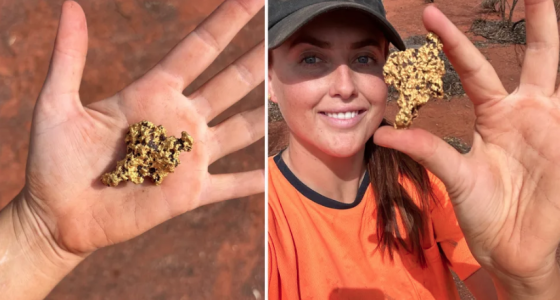Discover the 'rare' outback treasure that sold for $9,500
By
VanessaC
- Replies 5
While many of us spent our childhoods playing with toys or exploring the neighbourhood on our bikes, Tyler Mahoney was embarking on a different kind of adventure.
Growing up in Kalgoorlie, Western Australia, Mahoney was introduced to the world of gold prospecting at a young age.
Now, at 28, she's a fourth-generation gold prospector who recently sold a massive nugget for an impressive $9,500.
'It's a nice chunk of gold,' Mahoney said in an interview, her excitement palpable.
The nugget, discovered during one of her regular prospecting expeditions, is estimated to be about 94 per cent pure, or about 22-carat gold.
While smaller pieces of gold are more common finds and contribute to her regular income, it's these larger nuggets—such as her $2,500 find and her $7,000 find—that truly pay off.
Gold mining has a long history in Western Australia, dating back to the 1880s.
The first gold rush was sparked by the discovery of the 'Golden Mile' at Kalgoorlie in the 1890s.
However, nuggets as large as Mahoney found are becoming increasingly rare, making her find all the more remarkable.
'We could be seeing nuggets like four times a week and then we could go through a really big dry spell and not see a decent-sized nugget for six months,' she explained.
This unpredictability adds a premium to the value of alluvial gold—gold that has moved away from its original source.
These nuggets are worth about 30 per cent more than bullion—or refined gold—like ingots, coins and bars.
As such, Mahoney's nugget was quickly snapped up by an eager investor for close to $10,000.
Currently, gold sells for about $3,000 per ounce in Australia.
'Most of our gold goes to a lot of international customers, but this one went to Queensland,' Mahoney said.
'A nugget this size is definitely worth a lot more kept as a natural nugget.'
'Because of how rare they are and how hard they are to find, there's a really high demand for them and a low supply.'
The gold market has always been robust, but it has seen a recent surge in popularity, particularly among European and American buyers drawn to Australian gold.
Mahoney believes this is likely due to gold's enduring value, especially during global unrest.
'Gold is pretty much in every Australian state, but Western Australia, Victoria and Queensland are the three biggest producers,' Mahoney shared.
'We're pretty lucky that we've got gold pretty much everywhere and Australians, we are known for our big gold nuggets.'
Mahoney encourages holding onto nuggets of this size as long as possible, insisting that gold is a great investment.
Despite the presence of some 'pretty dodgy people in the gold game', she has built a trustworthy reputation and a significant social media following of over 200K followers who tune in daily to watch and learn from her prospecting adventures.
Prospecting, particularly in Australia, involves a lot of research.
'Prospecting is the search of gold before you mine it, there's a lot of reading the ground. We do a lot of research looking at geology and topography,' she explained.
'Our goal is to track that gold then find it and trace it back to the source—which is usually ironstone load or quartz reef. Then we would find the source.'
'But over thousands of thousands of years, that source can kind of disintegrate and break up. So it might not be there anymore, or it might be far under the surface and we can never find it'
Despite the challenges, including sometimes working in 40-degree weather, Mahoney finds prospecting 'really addictive'. She's even written a book about her adventures.
She also notes that the industry has evolved significantly since her great-grandfather's time, with more technology available and greater acceptance of women in the field.
 What are your thoughts on Mahoney’s latest find? Have you ever tried prospecting for gold? Tell us in the comments below.
What are your thoughts on Mahoney’s latest find? Have you ever tried prospecting for gold? Tell us in the comments below.
Growing up in Kalgoorlie, Western Australia, Mahoney was introduced to the world of gold prospecting at a young age.
Now, at 28, she's a fourth-generation gold prospector who recently sold a massive nugget for an impressive $9,500.
'It's a nice chunk of gold,' Mahoney said in an interview, her excitement palpable.
The nugget, discovered during one of her regular prospecting expeditions, is estimated to be about 94 per cent pure, or about 22-carat gold.
While smaller pieces of gold are more common finds and contribute to her regular income, it's these larger nuggets—such as her $2,500 find and her $7,000 find—that truly pay off.
Gold mining has a long history in Western Australia, dating back to the 1880s.
The first gold rush was sparked by the discovery of the 'Golden Mile' at Kalgoorlie in the 1890s.
However, nuggets as large as Mahoney found are becoming increasingly rare, making her find all the more remarkable.
'We could be seeing nuggets like four times a week and then we could go through a really big dry spell and not see a decent-sized nugget for six months,' she explained.
This unpredictability adds a premium to the value of alluvial gold—gold that has moved away from its original source.
These nuggets are worth about 30 per cent more than bullion—or refined gold—like ingots, coins and bars.
As such, Mahoney's nugget was quickly snapped up by an eager investor for close to $10,000.
Currently, gold sells for about $3,000 per ounce in Australia.
'Most of our gold goes to a lot of international customers, but this one went to Queensland,' Mahoney said.
'A nugget this size is definitely worth a lot more kept as a natural nugget.'
'Because of how rare they are and how hard they are to find, there's a really high demand for them and a low supply.'
The gold market has always been robust, but it has seen a recent surge in popularity, particularly among European and American buyers drawn to Australian gold.
Mahoney believes this is likely due to gold's enduring value, especially during global unrest.
'Gold is pretty much in every Australian state, but Western Australia, Victoria and Queensland are the three biggest producers,' Mahoney shared.
'We're pretty lucky that we've got gold pretty much everywhere and Australians, we are known for our big gold nuggets.'
Mahoney encourages holding onto nuggets of this size as long as possible, insisting that gold is a great investment.
Despite the presence of some 'pretty dodgy people in the gold game', she has built a trustworthy reputation and a significant social media following of over 200K followers who tune in daily to watch and learn from her prospecting adventures.
Prospecting, particularly in Australia, involves a lot of research.
'Prospecting is the search of gold before you mine it, there's a lot of reading the ground. We do a lot of research looking at geology and topography,' she explained.
'Our goal is to track that gold then find it and trace it back to the source—which is usually ironstone load or quartz reef. Then we would find the source.'
'But over thousands of thousands of years, that source can kind of disintegrate and break up. So it might not be there anymore, or it might be far under the surface and we can never find it'
Despite the challenges, including sometimes working in 40-degree weather, Mahoney finds prospecting 'really addictive'. She's even written a book about her adventures.
She also notes that the industry has evolved significantly since her great-grandfather's time, with more technology available and greater acceptance of women in the field.
Key Takeaways
- Tyler Mahoney, a fourth-generation gold prospector from Kalgoorlie, Western Australia, sold a large gold nugget for $9,500, highlighting the booming gold market.
- Mahoney found the 22-carat nugget, which is getting rarer to find, and sold it to an investor from Queensland.
- The gold market is currently on the rise, with increasing popularity and demand, especially from international customers who value Australian gold.
- Despite the challenging conditions and the evolution of gold prospecting, Mahoney continues the family tradition with modern technology, research, and social media engagement.








